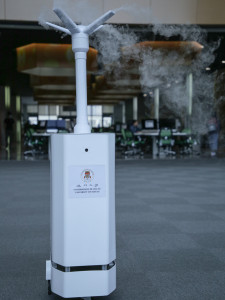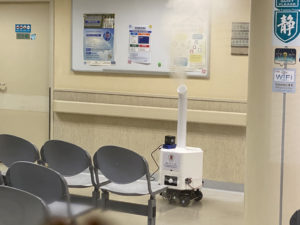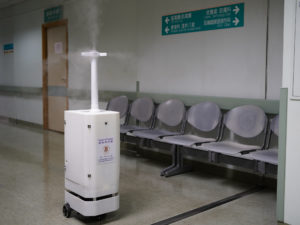Prof Xu Qingsong and his team in the University of Macau’s (UM) Faculty of Science and Technology (FST) have developed Smart Cleaner, a low-cost, obstacle-avoiding, full-orientation, intelligent disinfection robot with autonomous positioning and navigation. The robot was unveiled at the opening ceremony for the university’s 40th anniversary and the Open Day held earlier. The team is actively working with Wu Yee Sun Library of UM and designing a customised and upgraded version of intelligent disinfection robots for the university library by adjusting to the needs of the library. At present, Prof Xu’s team has provided free disinfection services for several parties, including Kiang Wu Hospital and government offices. The users provided excellent feedback and suggested that they could be further commercialised. The team hopes that these disinfection robots will be able to contribute to the fight against the epidemic.
Independent R&D Conducive to Popularisation
Smart Cleaner can substitute for disinfection staff in areas with severe outbreaks and perform disinfection and sterilisation of air and surface with multi-robot cooperation, reducing the risk of infection to frontline workers. In this issue, Prof Xu and his team share their story behind the development of the robot.
According to Prof Xu, he and his team started to develop the robot in April 2020. The development of the components, programmes, modules, appearance design and assembly were all performed in-house. This is the reason why they were able to keep the cost low, which is beneficial for the popularisation of the robot. ‘Each of our robots costs around MOP25,000 to MOP35,000, but robots with similar functions currently sell for about MOP370,000 on the market,’ he says.
‘Our robot is compatible with a wide range of disinfectants. It uses the super-dry atomisation technique and disperses the atomised droplets to the disinfection area through high-speed airflow to achieve large-space, three-dimensional sterilisation,’ explains Prof Xu. According to him, the robot mainly uses 6% hydrogen peroxide disinfectant with silver ion for atomisation disinfection. In previous lab tests, the disinfectant sprayed by the robot reached a concentration of 600-800ppm (mg/L) in ten minutes and disinfected a space of 100 square metres within 15 minutes, with 99% disinfection and sterilisation. Prof Xu says that the robot uses a dry atomised disinfectant solution, so the chemical will dissipate quickly under ventilation instead of remaining in the disinfection area, which will reduce the damage to the skin and the respiratory tract.However, the disinfection robot is not available to patrons on weekdays, as it is only ‘on duty’ every night after the library is closed, taking into account that some patrons may be sensitive to the chemicals contained in the disinfectant.
Good Disinfection Helper
The robot is approximately one metre tall and weighs 25 kilograms. It can be used for three to five hours on a full charge. The robot consists of four modules, namely the intelligent mobile robot module which controls the robot’s movement and disinfectant concentration, the disinfectant module for disinfectant spraying, the status monitoring module that monitors the humidity and the robot’s power level, and the power supply module to supply electricity. Through the self-developed communication system, the robot implements AI-based distributed scheduling and achieves intelligent collaboration of multiple robots, leading to safe and efficient completion of disinfecting tasks.
‘As long as the information about the disinfection site is pre-set in the system, the robot can scan the site with its radar and automatically create a map, plan its own trajectory and navigation, and avoid obstacles by scanning with the radar to disinfect as it goes,’ explains Prof Xu. He adds that users can choose to use the handle to direct the robot according to their needs or plan the disinfection route for the robot via the computer in advance. In environments with poor signal reception, such as warehouses or ICU units, users can use the camera and handle on the robot to view its surroundings and direct it, respectively.
Past Experience Helps Current Research
Prof Xu is grateful for the financial support of the Science and Technology Development Fund, Macau, the support of the FST in terms of manpower and material resources, as well as the professional monitoring of air quality indicators provided by the Institute for the Development and Quality, Macau, for the development and future applications of the robots.
Prior to the introduction of this robot, Prof Xu had been conducting robotics-related research for more than ten years, developing industrial robots, robotic arms, and bio-cellular micro/nano-manipulation robots. ‘The control technology and mechanical design aspects of disinfection robots have been applied to a number of robots we have developed in the past. We can say that we are building on our previous innovations. In the future, we hope to apply our technology to the society and further commercialise our research findings for the benefit of the community,’ he says.
澳門大學科技學院徐青松教授團隊自主研發的助抗疫智能機器人——消毒智多星,早前在澳大舉行的40週年校慶啟動儀式暨開放日當天在圖書館公開亮相。團隊正與大學圖書館合作,結合大學圖書館的需求,為圖書館設計定製升級版的智能消毒機器人。徐教授團隊研發的機器人還在鏡湖醫院門診大樓、政府辦公場所等進行消毒服務,用家反應甚好,並希望可以訂製購買,「我們希望消毒機器人能為抗擊疫情作出貢獻。」
自主研發利普及
這款可助抗疫的智能機器人——消毒智多星是一台低成本、具備全自主定位導航、智能避障、360度全方位消毒,能替代消毒人員深入疫情嚴重的地方,多機協作,實現空氣和物表消毒滅菌,減少前線人員的感染風險。徐教授表示,他和團隊去年四月起研發這台機器人,由零件、程式、各個模組、外觀設計乃至組裝,都是團隊自主研發,所以能將成本控制得較低,有利機器人的普及。「我們每台機器人成本約為澳門元25,000至35,000,但目前市面上具備類似功能的機器人售價約澳門元37萬。」
徐教授說:「團隊研發的機器人,能使用超乾霧化多種消毒液,並通過高速氣流將霧化後的霧滴彌散到消毒區域,實現大空間、三維立體化消毒。」機器人主要使用採用帶銀離子6%的過氧化氫消毒液來進行霧化消毒,在測試當中,機器人噴灑的消毒液在10分鐘內可達到600-800ppm(mg/L)濃度,僅需15分鐘即可消毒100平方米的空間,消毒殺菌效果達到99%。
徐教授說:「智能消毒機器人採用的是乾霧化消毒液,所以在消毒過程中,消毒液不會殘留,在通風的情況下散去得快,減低對皮膚和呼吸道的傷害。」平日讀者無法在大學圖書館見到這消毒機器人,因為圖書館考慮到有些讀者可能對消毒劑所含的化學成分敏感,現時機器人只在每晚圖書館閉館後才在館內「值班」消毒。
消毒好幫手
這款機器人約一米高,25公斤重,充滿電可以使用三至五小時。機器人由四個模組組成,分別是控制機器人移動及消毒劑濃度的智能移動機器人模組,負責噴灑消毒劑的消毒模組,能監控濕度、機器人電量等的狀態監控模組,以及負責供電的電源模組,並通過自主研發通信系統實現AI分佈調度,實現多機器人智能協作、安全更高效完成消毒任務。
「只要預先在系統設定好消毒地點的資訊,機器人就能在無人操控的情況下,通過雷達掃瞄該地點並建立地圖,自主規劃路徑和導航,並能通過雷達掃瞄避障,邊走邊消毒。」徐教授說,用家可根據自身需要,選擇使用手柄指揮機器人,或預先通過電腦為機器人規劃消毒路線。遇上訊號接收不良的環境,如倉庫或ICU病房,用家可利用機器人身上的鏡頭查看機器人身處的環境,使用手柄指揮機器人消毒。
過去經驗助研發
「澳門科技發展基金、澳大科技學院在人力物力方面的支持,以及澳門發展與質量研究所為檢測機器人消毒效果而提供的空氣指標專業監測,才能有助機器人的研發、應用。」徐教授說。
在這款機器人問世前,徐教授已進行了10多年機器人的相關研究,曾研發過工業機器人、機械臂,還研發過生物細胞微納米操作機器人。他說:「消毒機器人中的控制技術、機械設計等方面都曾在過去多個我們研發的機器人身上應用過。可以說是在以前的基礎上創新。未來,我們希望將科研技術應用到社會上去,實現科研成果產業化,造福社群。」

Prof Xu has more than ten years
of experience in developing robots
Prof Xu and his team present the healthcare
anti-epidemic robot to the UM library
Healthcare anti-epidemic intelligent robots
disinfect in the outpatient department of Kiang Wu Hospital





